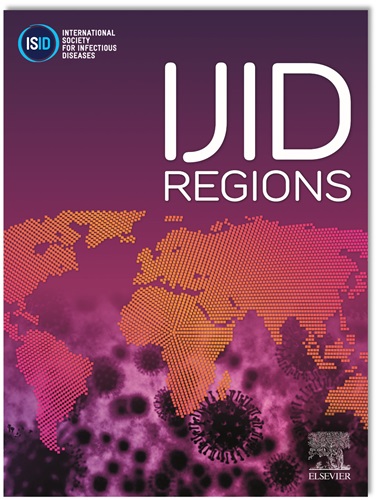Use of murine model to study virulence of epidemically significant Mycobacterium tuberculosis genotypes and to evaluate effectiveness of chemotherapy
IF 4.8
2区 医学
Q1 INFECTIOUS DISEASES
引用次数: 0
Abstract
Introduction
The clinical manifestations of tuberculosis (TB) in humans represent a complex interaction between the causative agent, Mycobacterium tuberculosis, and the immune response of the human host. Using the murine model, we compared virulence of M. tuberculosis strains of the medically significant genotypes and evaluated the effectiveness of anti-TB therapy and inflammatory response in infected mice.
Methods
The C57BL/6 mice were infected with multidrug-resistant clinical M. tuberculosis strains of Beijing and LAM genotypes. Control groups were not treated and experimental groups received adequate treatment with moxifloxacin, linezolid, bedaquiline and perchlozone. After 2 and 5.5 months of therapy, groups of mice were euthanized and studied for bacterial load, histology, lung pathology, and biochemical markers of liver damage. Whole genome sequencing was performed on all bacterial isolates from the lungs of the treated mice and the obtained fastq files were analyzed using SAM-TB tool and Geneious package. This study was funded by Russian Science Foundation (grant 24-44-00004).
Results
The anti-TB therapy reduced the inflammation and tuberculous lung damage in all groups of mice, even in those infected with the most virulent strain Beijing 396. A significant effect of the anti-TB therapy was observed at both time-point for all groups. The highest effectiveness of the therapy was observed in mice infected with the least virulent strains Beijing 6691 and LAM 7074. At the same time, in 3 out of 4 groups of treated mice (except for those infected with the low-virulent strain LAM 7074), a slight increase in bacterial load was recorded by the end of the 5.5-month course of therapy. High-coverage WGS analysis showed that no mutations associated with resistance to the administered drugs emerged after 5.5 months of treatment. The study of non-specific inflammatory response revealed the differently severe acute inflammation in mice infected with different strains.
Discussion
The highest lung damage was observed in treated mice infected with Beijing 396, the lowest – in mice infected with low-virulent Beijing 6691 and LAM 7074. At the same time, the contrasting inflammatory responses were observed in mice infected with the LAM strains: the highest in those infected by highly-virulent strain 4542 (SIT266), the lowest – in mice infected with low-virulent strain 7074 (SIT252). Phylogenetically, these LAM strains belong to the genetically homogeneous LAM-RUS branch and their contrasting in vivo manifestation is noteworthy.
Conclusions
Some of the observed differences between studied strains distinguish between low-virulent and highly-virulent strains irrespective of the genotype. On the other hand, some other features were common for the strains of the same genotype either Beijing or LAM and might correlate with deeply rooted lineage-specific evolutionary changes in genomes. Overall, our results emphasize the diversity of ways in which M. tuberculosis strains of different genotypes adapt to the host.
求助全文
约1分钟内获得全文
求助全文
来源期刊
CiteScore
18.90
自引率
2.40%
发文量
1020
审稿时长
30 days
期刊介绍:
International Journal of Infectious Diseases (IJID)
Publisher: International Society for Infectious Diseases
Publication Frequency: Monthly
Type: Peer-reviewed, Open Access
Scope:
Publishes original clinical and laboratory-based research.
Reports clinical trials, reviews, and some case reports.
Focuses on epidemiology, clinical diagnosis, treatment, and control of infectious diseases.
Emphasizes diseases common in under-resourced countries.

 求助内容:
求助内容: 应助结果提醒方式:
应助结果提醒方式:


